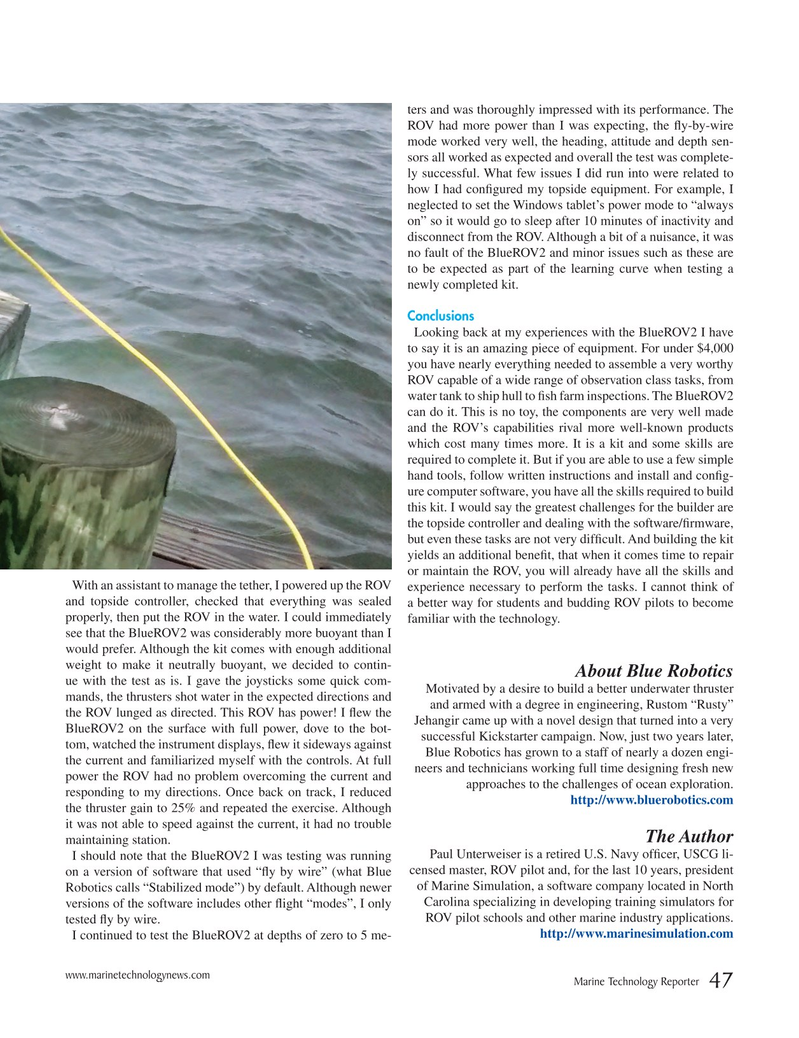
Page 47: of Marine Technology Magazine (November 2016)
Subsea Engineering & Construction
Read this page in Pdf, Flash or Html5 edition of November 2016 Marine Technology Magazine
ters and was thoroughly impressed with its performance. The
ROV had more power than I was expecting, the ? y-by-wire mode worked very well, the heading, attitude and depth sen- sors all worked as expected and overall the test was complete- ly successful. What few issues I did run into were related to how I had con? gured my topside equipment. For example, I neglected to set the Windows tablet’s power mode to “always on” so it would go to sleep after 10 minutes of inactivity and disconnect from the ROV. Although a bit of a nuisance, it was no fault of the BlueROV2 and minor issues such as these are to be expected as part of the learning curve when testing a newly completed kit.
Conclusions
Looking back at my experiences with the BlueROV2 I have to say it is an amazing piece of equipment. For under $4,000 you have nearly everything needed to assemble a very worthy
ROV capable of a wide range of observation class tasks, from water tank to ship hull to ? sh farm inspections. The BlueROV2 can do it. This is no toy, the components are very well made and the ROV’s capabilities rival more well-known products which cost many times more. It is a kit and some skills are required to complete it. But if you are able to use a few simple hand tools, follow written instructions and install and con? g- ure computer software, you have all the skills required to build this kit. I would say the greatest challenges for the builder are the topside controller and dealing with the software/? rmware, but even these tasks are not very dif? cult. And building the kit yields an additional bene? t, that when it comes time to repair or maintain the ROV, you will already have all the skills and
With an assistant to manage the tether, I powered up the ROV experience necessary to perform the tasks. I cannot think of and topside controller, checked that everything was sealed a better way for students and budding ROV pilots to become properly, then put the ROV in the water. I could immediately familiar with the technology.
see that the BlueROV2 was considerably more buoyant than I would prefer. Although the kit comes with enough additional weight to make it neutrally buoyant, we decided to contin-
About Blue Robotics ue with the test as is. I gave the joysticks some quick com-
Motivated by a desire to build a better underwater thruster mands, the thrusters shot water in the expected directions and and armed with a degree in engineering, Rustom “Rusty” the ROV lunged as directed. This ROV has power! I ? ew the
Jehangir came up with a novel design that turned into a very
BlueROV2 on the surface with full power, dove to the bot- successful Kickstarter campaign. Now, just two years later, tom, watched the instrument displays, ? ew it sideways against
Blue Robotics has grown to a staff of nearly a dozen engi- the current and familiarized myself with the controls. At full neers and technicians working full time designing fresh new power the ROV had no problem overcoming the current and approaches to the challenges of ocean exploration.
responding to my directions. Once back on track, I reduced http://www.bluerobotics.com the thruster gain to 25% and repeated the exercise. Although it was not able to speed against the current, it had no trouble
The Author maintaining station.
Paul Unterweiser is a retired U.S. Navy of? cer, USCG li-
I should note that the BlueROV2 I was testing was running censed master, ROV pilot and, for the last 10 years, president on a version of software that used “? y by wire” (what Blue of Marine Simulation, a software company located in North
Robotics calls “Stabilized mode”) by default. Although newer
Carolina specializing in developing training simulators for versions of the software includes other ? ight “modes”, I only
ROV pilot schools and other marine industry applications.
tested ? y by wire.
http://www.marinesimulation.com
I continued to test the BlueROV2 at depths of zero to 5 me- www.marinetechnologynews.com
Marine Technology Reporter 47
MTR #9 (34-49).indd 47 MTR #9 (34-49).indd 47 12/7/2016 3:58:19 PM12/7/2016 3:58:19 PM

 46
46

 48
48
